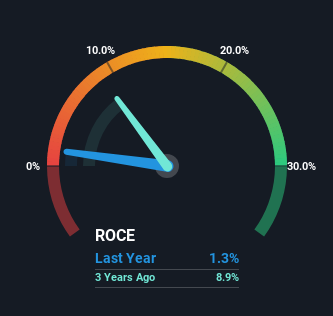- South Korea
- /
- Healthtech
- /
- KOSDAQ:A032620
UBcare (KOSDAQ:032620) Might Be Having Difficulty Using Its Capital Effectively

To find a multi-bagger stock, what are the underlying trends we should look for in a business? One common approach is to try and find a company with returns on capital employed (ROCE) that are increasing, in conjunction with a growing amount of capital employed. Ultimately, this demonstrates that it's a business that is reinvesting profits at increasing rates of return. However, after investigating UBcare (KOSDAQ:032620), we don't think it's current trends fit the mold of a multi-bagger.
What Is Return On Capital Employed (ROCE)?
For those who don't know, ROCE is a measure of a company's yearly pre-tax profit (its return), relative to the capital employed in the business. To calculate this metric for UBcare, this is the formula:
Return on Capital Employed = Earnings Before Interest and Tax (EBIT) ÷ (Total Assets - Current Liabilities)
0.013 = ₩1.7b ÷ (₩168b - ₩39b) (Based on the trailing twelve months to March 2024).
Therefore, UBcare has an ROCE of 1.3%. Ultimately, that's a low return and it under-performs the Healthcare Services industry average of 9.7%.
See our latest analysis for UBcare

While the past is not representative of the future, it can be helpful to know how a company has performed historically, which is why we have this chart above. If you'd like to look at how UBcare has performed in the past in other metrics, you can view this free graph of UBcare's past earnings, revenue and cash flow.
What The Trend Of ROCE Can Tell Us
When we looked at the ROCE trend at UBcare, we didn't gain much confidence. Around five years ago the returns on capital were 11%, but since then they've fallen to 1.3%. However, given capital employed and revenue have both increased it appears that the business is currently pursuing growth, at the consequence of short term returns. And if the increased capital generates additional returns, the business, and thus shareholders, will benefit in the long run.
While on the subject, we noticed that the ratio of current liabilities to total assets has risen to 23%, which has impacted the ROCE. Without this increase, it's likely that ROCE would be even lower than 1.3%. Keep an eye on this ratio, because the business could encounter some new risks if this metric gets too high.
The Bottom Line On UBcare's ROCE
Even though returns on capital have fallen in the short term, we find it promising that revenue and capital employed have both increased for UBcare. These growth trends haven't led to growth returns though, since the stock has fallen 22% over the last five years. As a result, we'd recommend researching this stock further to uncover what other fundamentals of the business can show us.
On a separate note, we've found 2 warning signs for UBcare you'll probably want to know about.
For those who like to invest in solid companies, check out this free list of companies with solid balance sheets and high returns on equity.
New: AI Stock Screener & Alerts
Our new AI Stock Screener scans the market every day to uncover opportunities.
• Dividend Powerhouses (3%+ Yield)
• Undervalued Small Caps with Insider Buying
• High growth Tech and AI Companies
Or build your own from over 50 metrics.
Have feedback on this article? Concerned about the content? Get in touch with us directly. Alternatively, email editorial-team (at) simplywallst.com.
This article by Simply Wall St is general in nature. We provide commentary based on historical data and analyst forecasts only using an unbiased methodology and our articles are not intended to be financial advice. It does not constitute a recommendation to buy or sell any stock, and does not take account of your objectives, or your financial situation. We aim to bring you long-term focused analysis driven by fundamental data. Note that our analysis may not factor in the latest price-sensitive company announcements or qualitative material. Simply Wall St has no position in any stocks mentioned.
Have feedback on this article? Concerned about the content? Get in touch with us directly. Alternatively, email editorial-team@simplywallst.com
About KOSDAQ:A032620
UBcare
Provides electronic medical record solutions for hospitals, clinics, and pharmacies in South Korea and the United States.
Excellent balance sheet and good value.
Market Insights
Community Narratives




